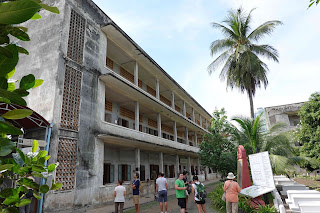If you’ve read the book First they Killed My Father or seen the film of the book directed by Angelina Jolie, you’ll understand my reluctance and actual fear to visit the Killing Fields outside of Phnom Penh and the Genocide Museum in town. The book recounts the horror and atrocities of the brutal Khmer Rouge regime under the madman Pol Pot during the nightmare period from 1975 to 1978.
 |
| Memorial Tower at Killing Fields |
I won’t go into a lot of the history that led to the genocide, if interested you should read the book, but basically American bombing of Cambodia during the Vietnam war forced thousands of Cambodians to flee the countryside for the safety of Phnom Penh. Cambodia was the most bombed country not just during the war, but in history. The bombings, starvation and hardships made life in the countryside unbearable and people without hope welcomed the change they thought the Khmer Rouge would bring. Over a million desperate people fled to Phnom Penh swelling the population to three million. They actually cheered the soldiers as the Khmer Rouge took over the city.
Sadly, the madman Pol Pot backed by communist Russia and China launched a massive genocide in the name of social revolution—a failed experiment inspired by Mao’s communist regime in China. Almost the entire population of Phnom Penh was forced out of the city as part of Pol Pot’s utopian agrarian vision. A third of the entire Cambodian population was murdered, starved to death or died from illness or disease—three million people out of a population of roughly 10 million!
But it wasn’t just the genocide of his own people that is so shocking and horrific, it is the brutal way men, women and children were tortured and slaughtered. The details are chilling. Horror stories from the few survivors are the chimera of nightmares.
Hence my trepidation to visit the Killing Fields and the shocking prison, now the Genocide Museum, where the atrocities were carried out. If you left the prison, it meant you were shipped off to the killing fields and crudely dispatched with farm tools in order to save bullets. Death was not swift or painless. Thrown into mass graves the bodies were covered with DDT to mask the smell, sometimes while the victims were still alive.
 |
| Mass graves now shallow depressions |
I took very few photographs because of my shock. But my photos could not possibly convey the horror, the gut-wrenching chill, the deep sadness one feels when you see the pits of mass graves, now shallow depressions in the grassy field. Worse still is the display of skulls arrayed in a memorial tower 17 rows high. Bone fragments and teeth regularly wash up to the surface of the field after a rain and are collected by staff. And then there is the tree where babies were bashed to their death.
If you now find it hard to breathe, you can’t swallow, or a tear comes to your eye, I will have succeeded in conveying a small fraction of the deep sadness, horror and depression I felt. I want this to be as difficult for you to read as it was for me to witness.
 |
| 5,000 skulls in 17 rows on 4 sides of memorial tower |
A stillness comes over the two sites as people follow the guided trail in stunned silence. No one speaks as we shuffle along the path listening to the horrible details and tales of the few survivors, of the child soldiers who were forced to murder or be murdered, of the farmers who discovered the pits when they went searching for food after the fall of the regime. Sadly this killing field was just one of many.
In a sad juxtaposition of history and memory loss, these children were playing with memorial ribbons left on the "Killing Tree" against which soldiers bashed the heads of babies before throwing them into the mass graves.
At the prison in Phnom Penh (one of hundreds around the country), where only 12 survived of the thousands tortured there, you tour the small torture rooms of what was once a high school, now a testament to incredible suffering. Iron shackles on beds held the victims in place and blood stains on the floor testify to their suffering and their brutal murders.
 |
| Torture prison, a former high school |
Fourteen grave markers indicate where the last victims to die at the prison are remembered. They were left to bleed out when their torturers fled the invading Vietnamese “liberation” army.
 |
| Ammunition bucket for human waste |
In one room a bare metal bed shows the leg shackles that held the torture victims in place. The rule was do not scream or you will be beaten worse.
Another building in the prison complex was full of tiny holding pens made of bricks. Can you imagine the heat. The exit was covered in barbed wire to prevent escape or suicide even though victims were shackled together at the ankles.
Incredibly, two survivors are at the prison to tell their stories through their books. One is a painter who was saved because he could accurately depict the torture and deaths, and the other a skilled labourer who was spared because he could repair the typewriters used to record the sordid details.
It is all too depressing and nightmarish for me to recount and give any justice to the victims and the method of their deaths.
Yet I felt a moral obligation to visit and to tell my experience out of respect for the victims and in a small hope that somehow sharing their story will help prevent future atrocities.




No comments:
Post a Comment